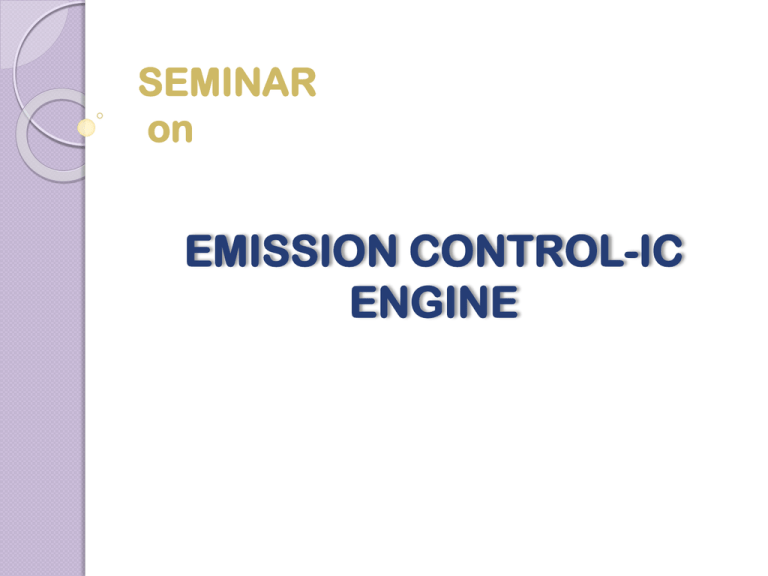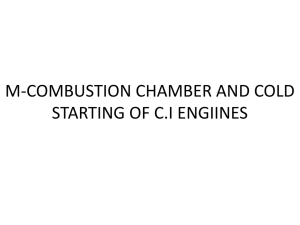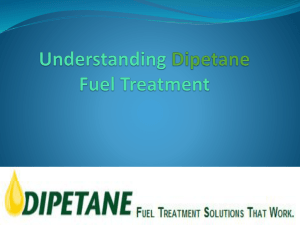save-emission control
advertisement

SEMINAR on EMISSION CONTROL-IC ENGINE Introduction The need to control the emissions from automobiles gave rise to the computerization of the automobile. Hydrocarbons, carbon monoxide and oxides of nitrogen are created during the combustion process and are emitted into the atmosphere from the tail pipe. The clean air act of 1977 set limits as to the amount of each of these pollutants that could be emitted from an automobile. The manufacturers answer was the addition of certain pollution control devices and the creation of a selfadjusting engine. . An oxygen sensor was installed in the exhaust system and would measure the fuel content of the exhaust stream. It then would send a signal to a microprocessor, which would analyze the reading and operate a fuel mixture or air mixture device to create the proper air/fuel ratio. Methods to reduce emission in SI engine. 1. Catalytic Converter Automotive emissions are controlled in three ways; one is to promote more complete combustion so that there is less by products. The second is to reintroduce excessive hydrocarbons back into the engine for combustion and the third is to provide an additional area for oxidation or combustion to occur. This additional area is called a catalytic converter. 2. PCV Valve The purpose of the positive crankcase ventilation (PCV) system is to take the vapors produced in the crankcase during the normal combustion process, and redirecting them into the air/fuel intake system to be burned during combustion. These vapors dilute the air/fuel mixture, they have to be carefully controlled and metered so as not to affect the performance of the engine. 3. EGR Valve The purpose of the exhaust gas recirculation valve (EGR) valve is to meter a small amount of exhaust gas into the intake system; this dilutes the air/fuel mixture so as to lower the combustion chamber temperature. Excessive combustion chamber temperature creates oxides of nitrogen, which is a major pollutant. While the EGR valve is the most effective method of controlling oxides of nitrogen, in it's very design it adversely affects engine performance. . 4. Evaporative Controls Gasoline evaporates quite easily. In the past these evaporative emissions were vented into the atmosphere. 20% of all HC emissions from the automobile are from the gas tank. In 1970 legislation was passed, prohibiting venting of gas tank fumes into the atmosphere. An evaporative control system was developed to eliminate this source of pollution. The function of the fuel evaporative control system is to trap and store evaporative emissions from the gas tank and carburetor. A charcoal canister is used to trap the fuel vapors. 5. Air Injection . Since no internal combustion engine is 100% efficient, there will always be some unburned fuel in the exhaust. This increases hydrocarbon emissions. To eliminate this source of emissions an air injection system was created. Combustion requires fuel, oxygen and heat. Without any one of the three combustion cannot occur. Inside the exhaust manifold there is sufficient heat to support combustion, if we introduce some oxygen than any unburned fuel will ignite. This combustion will not produce any power, but it will reduce excessive hydrocarbon emissions. Unlike in the combustion chamber, this combustion is uncontrolled, so if the fuel content of the exhaust is excessive, explosions that sound like popping will occur. Modification in SI engine to reduce emission. • Multi-port fuel injection system to completely replace carburetors. •Electronic engine management to accurately regulate fuel supply to cylinders by sensing various engine parameters. •4-valve system to replace 2-valve system, improved combustion chamber design and improved inlet manifold design for axial stratification of charge. •Turbo-charged (TC) and Turbo-charged After Cooled (TCAC) engines. •Turbo-compounded engines; they are found to be up to 18 per cent better than the conventional engines. •Use of ceramic components (e.g., low density Silicon Nitride, Si3N4) such as piston pins, valves, blades in turbochargers. Methods to reduce emission in CI engine 1. Particulate filter. Particulate filters are highly effective in the elimination of particulate matter (PM10) or soot from diesel exhaust. It has a variety of filter coatings and designs, depending of the engine application and duty cycle. 2. Selective catalytic reduction Selective Catalytic Reduction of NOx (generally abbreviated with SCR deNOx) is a very powerful technology to reduce the NOx emission and fuel consumption of truck and passenger car diesel engines. The European truck manufacturers starting in October 2005, when EURO-4 emissions legislation enters into force, will introduce SCR deNOx on a large scale. Modification in CI engine to reduce emission 1. Commercial vehicle emission control Improvement in fuel injection system and use of higher injection pressure. Common rail system unit injections instead of multicylinder fuel injection pumps. Electronically controlled injection system to provide variable injection timing with good dynamic response to engine load, speed, and temperature. Improved cylinder head design, inlet port, re-entrant combustion chambers. 4-Valve system to improve volumetric efficiency and provide better mixing of fuel and air. 2. Passenger Car Diesel Engine In India, Indirect Injection (IDI) diesel engines are commonly used in passenger cars. Complete combustion of injected fuel. Minimum lube consumption. Retarded combustion. Moderate air motion. Particulate emission control is helped by, high injection pressure. fine fuel atomization. high excess air. Minimum lube consumption. EMISSION CONTROL NORMS IN SI AND CI ENGINE Level of Emission 2/3 Wheelers ## Norms 2-Stroke 4-Stroke * Intake, exhaust, Euro I /India 2000 4 Wheelers 4-Stroke * Intake, exhaust, combustion * 4-Stroke engine optimization technology * Catalytic converter combustion optimization *Carburetor optimization * Euro II / Bharat Stage II Secondary air * Hot tube injection * * Catalytic converter injection * CNG / LPG (3 wheelers only) Secondary * CNG / LPG (3 wheelers only) * Fuel injection air * Catalytic converter * Fixed EGR * Multi-valve * CNG/LPG * EuroIII/ Bharat Stage III * Fuel injection * Fuel injection * Catalytic converter * Carburetor+ catalytic converter Fuel injection +catalytic converter * Variable EGR * Variable valve timing * Multi-valve * On-board diagnostics system * CNG/LPG * Direct cylinder Euro IV / Bharat Stage IV * To be developed * Lean burn * Fuel injection+ catalytic converter injection * Multi-brick catalytic converter * On-board system diagnostics EMISSION CONTROL NORMS IN CI ENGINE Level Of Emission Norms Technology Options · Intake, exhaust and combustion optimisation Euro I / India 2000 · FIP~700-800 bar, low sac injectors · High swirl · Naturally aspirated · Turbo charging Euro II / Bharat Stage II · Injection pressure > 800 bar, moderate swirl · High pressure inline / rotary pumps, injection rate control · VO nozzles · Re-entrant combustion chamber · Lube oil consumption control · Multi valve, · Low swirl – high injection pressure > 120 bar Euro III / Bharat Stage III · Rotary pumps, pilot injection rate shaping · Electronic fuel injection · Critical lube oil consumption control · Variable geometry turbocharger (VGT) · Inter-cooling · Particulate trap Euro IV / Bharat Stage IV · NOx trap · On board Diagnostics system · Common rail injection-injection pressure>1600 bar · Fuel Cell · CNG/LPG CONCLUSION Efforts are being made to reduce the consumption of fossil fuels and maximize the utilization of environment-friendly energy sources and fuels for meeting energy needs. In India, the demand for oil for the transport sector is estimated to increase over the next decade. . Battery operated vehicles, fuel cell vehicles, hydrogen powered vehicles and bio-fuel powered vehicles have been identified in this context. The development activities of such fuels and vehicles need to be further encouraged particularly in view of their potential to protect the environment. Hybrid Electric Vehicles (HEVs) use the combination of engine of a conventional vehicle with electric motor powered by traction batteries and/or fuel cell. This combination helps in achieving both the energy and environmental goals. The deployment of a large number of this type of vehicles would help us in terms of environmental benefits, reduction of oil consumption and reduction in emissions.






